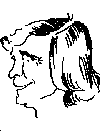Susannes Folksong-Notizen
 [1959:] [Früher] gebrauchte man die Bezeichnung 'hog-eye' für eine bestimmte Art von Bark, welche um die Mitte des vorigen Jahrhunderts häufig in Gebrauch war, als die ersten Goldfunde in Kalifornien gemacht worden waren, die mangelnde Erschließung der westlichen Verkehrswege aber den Verkehr zur See weit bequemer und schneller vonstatten gehen ließen als den zu Lande. Warum jene Barken 'hog-eyes' hießen, ist nicht mehr bekannt. Die 'hog-eye men' jedenfalls waren die Matrosen dieser Schiffe. [...] Die 'railroad navvies', von denen als Nebenbuhlern die Rede ist, sind jene Arbeiter, die an dem nun mit Eifer unternommenen transkontinentalen Bahn- und Straßenbau zu Tausenden als Erdarbeiter tätig waren. (Dahl 61) [1959:] [Früher] gebrauchte man die Bezeichnung 'hog-eye' für eine bestimmte Art von Bark, welche um die Mitte des vorigen Jahrhunderts häufig in Gebrauch war, als die ersten Goldfunde in Kalifornien gemacht worden waren, die mangelnde Erschließung der westlichen Verkehrswege aber den Verkehr zur See weit bequemer und schneller vonstatten gehen ließen als den zu Lande. Warum jene Barken 'hog-eyes' hießen, ist nicht mehr bekannt. Die 'hog-eye men' jedenfalls waren die Matrosen dieser Schiffe. [...] Die 'railroad navvies', von denen als Nebenbuhlern die Rede ist, sind jene Arbeiter, die an dem nun mit Eifer unternommenen transkontinentalen Bahn- und Straßenbau zu Tausenden als Erdarbeiter tätig waren. (Dahl 61)
 [1964:] Though familiar to British seamen, this song, used mainly for capstan work, was probably made in America. It's still a favourite there, evidently, for the folklorist Vance Randolph found several versions current among Missouri hill-folk nearly a thousand miles from the sea. Alas, Randolph's versions remain in manuscript, locked away in a Sex Research Institute in Indiana. The version here - melody, at least - was taken down in the 1860s. (A. L. Lloyd, notes 'Farewell Nancy') [1964:] Though familiar to British seamen, this song, used mainly for capstan work, was probably made in America. It's still a favourite there, evidently, for the folklorist Vance Randolph found several versions current among Missouri hill-folk nearly a thousand miles from the sea. Alas, Randolph's versions remain in manuscript, locked away in a Sex Research Institute in Indiana. The version here - melody, at least - was taken down in the 1860s. (A. L. Lloyd, notes 'Farewell Nancy')
 [1999:] I can't find an outright definition just now, but there are one or two suggestive references. In a book of shanties published about 1920 the author appeals to the experience of old salts, who know what the term means, and refuses to be any clearer. Legman (Horn Book, 1964, p. 401), talking about Hugill's unpublished unexpurgated collection, says that without it and one other manuscript "it would be impossible, in future times, actually to assess their erotic content from the absolutely terrified hints and dark implications (as about 'hog-eye') in all the printed chantey collections." The term isn't in Partridge's Dictionary of Slang, or its later revision by Beale, but I think a little reflection will bring the (maybe reluctant) conclusion that hog-eye means what it looks like, i.e. [to put it primly] the female pudendum. (Murray on Saltspring, www.mudcat.org, 4 Jun) [1999:] I can't find an outright definition just now, but there are one or two suggestive references. In a book of shanties published about 1920 the author appeals to the experience of old salts, who know what the term means, and refuses to be any clearer. Legman (Horn Book, 1964, p. 401), talking about Hugill's unpublished unexpurgated collection, says that without it and one other manuscript "it would be impossible, in future times, actually to assess their erotic content from the absolutely terrified hints and dark implications (as about 'hog-eye') in all the printed chantey collections." The term isn't in Partridge's Dictionary of Slang, or its later revision by Beale, but I think a little reflection will bring the (maybe reluctant) conclusion that hog-eye means what it looks like, i.e. [to put it primly] the female pudendum. (Murray on Saltspring, www.mudcat.org, 4 Jun)
 [1999:] The tow-path driver responsible for the draft animals which towed barges and canal boats on the old canal systems was known as the HOGGY; that possibly might be the basis for the term hog-eye, through folk etymology. (Bill in Alabama, www.mudcat.org, 7 Jun) [1999:] The tow-path driver responsible for the draft animals which towed barges and canal boats on the old canal systems was known as the HOGGY; that possibly might be the basis for the term hog-eye, through folk etymology. (Bill in Alabama, www.mudcat.org, 7 Jun)
http://www.mudcat.org/thread.cfm?threadid=11353 Walkaway shanty/Stamp 'n' go song
|



 Susannes Folksong-Notizen English Notes
Susannes Folksong-Notizen English Notes

